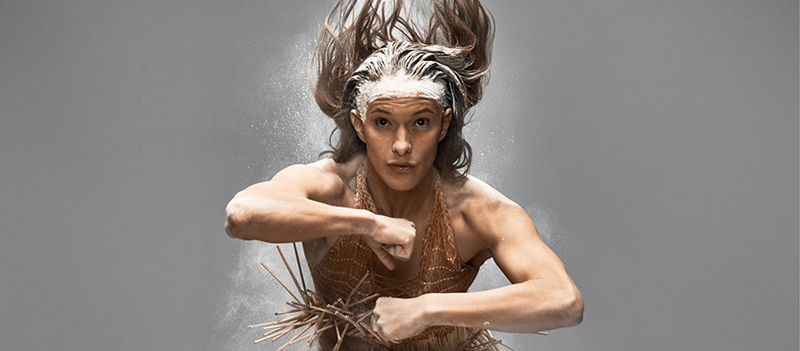Kotahi I & II - Atamira Dance Company
4 & 5 October 2018, Q Theatre, Auckland
TEMPO Dance Festival 2018
Reviewed by Briar Wilson

Trust Jack Gray to come up with the idea – a collaboration between Atamira and Australia’s National Aboriginal Islander Skills Development Association Dance College - and then, with Marama LLoydd, to put it into performance, and open Tempo dance festival!
The show had three pieces spread over the two nights, unfortunately for just the one time, with choreography from Louise Potiki Bryant, Gray, and Frances Rings. Rings is the head of Creative Studies at NAISDA, a college that is very well known and respected in Australia and she brought some students with her.
In the after show Q & A, Rings spoke of pleasure in expanding the views she shared with Gray on the problems of indigenous peoples by making a valid experience here to assist some to walk in the two worlds of the old and the contemporary.
On the first night, Kotahi 1, we saw Onepu (sand) from Potiki Bryant, based on Kai Tahu tradition and in celebration of women. It is the story of six atua wahine (women deities). The mother, Hine-pū-nui-o-toka, with three of her daughters, controls and releases to the world its principal winds, a fourth daughter controls the flight of the birds and a fifth (Ariana Tikao), controls cliff echoes
The stage was set with a sand bank in a large circle (to surround the world) centred by a small pyramid shaped mound of sand, with a kneeling Tikao, singing and lit with splintered projections from above.
The projections, which might also spread out into the circle, were the work of Potiki Bryant, and together with sound, changed to add meaning to each part of the dance. Sound or music was the work of Paddy Free and Tikao.
The first wind came from the north; she danced fiercely with strong energy, to a strong beat. Then came another sister who carried two large dried palm fronds that had been split into two with woven leaves (four of these beauties featured again later) followed by the mother to provide a calming influence.
The next sister’s dance was calm with smooth open movements to the sound and projections of the sea and waves breaking on the shore, and her bent shoulders and wide arms were like bird wings. Another sister, accompanied by sounds of sea and surf, held a long stick and signalled strength. The last sister carried gourds of different sizes which she revered. With the mother and another sister, they formed a totem image, which was quite lovely, the front one sitting on her heels, the next on her knees, and the mother standing, where they made a dance with engaging arm patterns.
In the finale, the dancers took to the sand, lifting it and letting it fall, spreading it widely over the stage with heart and passion, as if to indicate that the ground was laid ready for life.
Indigenous Stamina, Gray’s piece, began Kotahi ll, with dancer, Justine Hohaia, clad in black and voluminous white net, as a stately spirit, calmly in command. She was never far away from the action.
Another telling image was the entry of two girls with large squares of gold heat conservation material used for rescue. This was flashed about as the dance continued - strong movement signifying struggle.
When the five guys joined in a circle together, despairing shoulders and heads bowed inwards, it was like the folding petals of a flower going to sleep at night – would they wake up with the sun?
Other questions - is acting the funny guy the answer? Will a tape of self help advice from the lady from Arkansaw help? No, but to remember that the land never forgets may do so – and the “funny” guy sings a waiata with the girl with the guitar.
The dance vocabulary included poi, and like Potiki Bryant’s, there was a seamless blend of Maori movement with contemporary.
At the end, the group got together with talk of justice and self determination in a good rap
At this point the lights didn’t come up and the audience got a bit confused as to what was happening.
Rings’ piece, Shapeshift, like the other two, started with a single dancer on stage, lying under a moving spot. Words floated onto the curtains behind – “speak”, “heart”, “place”, “fear”, “hurt”, “rock”.
Later three large blackboards were brought on for the dancers to draw on - on one, a lined, strong, very masculine, face; on another, a heart with aorta and veins, and words were written on the third – some like “Goba” (not explained), others like “Ngati Whetu” were the names of iwi.
The cast of 15 (7 guys, 8 girls), in casual dark gear, were often all on stage to move as a group without insistence on total uniformity, and the show ended with a stirring unison, not unlike a haka!
The mix of cultures demonstrated the current need to tune into the ancestral past while living a contemporary life, in order to walk in both worlds in a healthy way, but generally, the dance language seemed to be under the contemporary mantle.
This piece was short relative to the others, and, like them, used a soundscape and projections.
It wasn’t obvious, but apparently the whole show was put together in three weeks!
